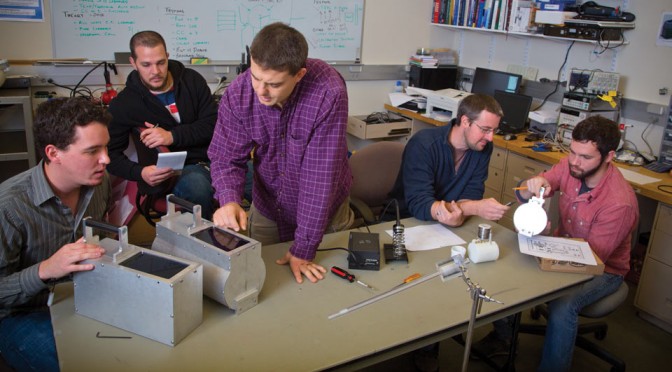In a small physics lab in Flarsheim Hall, Associate Professor Anthony Caruso and a team of student researchers are close to developing technology that could stop a future nuclear terrorist attack.
Caruso’s research, already responsible for attracting more than $3 million in funding, spinning off one commercial startup and the creation of a new line of products for another, didn’t start out to stop a nuclear terror threat.
But that changed when Caruso met a naval research program officer who believed that Caruso’s research may improve the ability to detect illicit nuclear material in transit.
“He was dead serious about this mission,” Caruso says. “Dead serious.”
When the program officer heard about Caruso’s portable neutron detection technology research, he saw an application for the Navy: a hand-held device that can detect particles emitted from nuclear material(s) on a ship, pinpoint their location and decipher what isotope they had come from.
The technology Caruso is developing is superior to existing nuclear detection tools on several levels.
The instrument could be light enough to carry; older technology is built using detectors and shapes that are heavy and bulky, anything but portable. It is based on the detection of neutrons, which aren’t easily blocked; older technology detected gamma rays only, which can easily be encased in lead or steel and blocked. And it can detect the location of nuclear particles and determine their source.
In 2009 Caruso’s team, including Professor Douglas McGregor from Kansas State University and Professor William Miller from the University of Missouri-Columbia, first began work on a portable nuclear detection device when awarded a grant from the Office of Naval Research. The team later demonstrated that the technology worked with testing at an East Coast naval base.
During the demonstration, the group’s spectrometer found and identified all of the nuclear sources that had been hidden in various places around a ship.
“That was a big deal as we had demonstrated the art-of-the-possible,” says Caruso, the project’s principal investigator.
Now the spectrometer needs to be transformed into a commercial product that can be manufactured and will hold up in real-life situations. Caruso estimates that finish line is still two years away.
A Kansas City-based startup called U2D Inc. has licensed the technology and is working on building the device the Navy may eventually use in the field. Radiation Detection Technologies Inc. in Manhattan, Kan., produces the detectors for the spectrometer and is developing detectors for other commercial applications.
Meanwhile, Caruso’s lab at UMKC is working on the next level of this research.
Caruso says the example provided by program officers and scientists at the Office of Naval Research and Naval Research Laboratory enriched his sense of patriotism.
“I busted my butt because I wanted to help solve this mission,” Caruso says. “It’s a huge deal.”
Prototype solid state neutron spectrometer
This third-generation prototype is used to scan and identify neutron-emitting sources.
The Portability:
The 18-pound instrument is lighter and much more efficient than similar instruments currently used by the U.S. Navy.
The Screen:
A Nexus 7 touchscreen pad lets the user manage and process the neutron data collected.
The Guts:
Inside the instrument, 128 individual semiconductor-based neutron detectors are embedded within the same kind of plastic used to make milk jugs.

